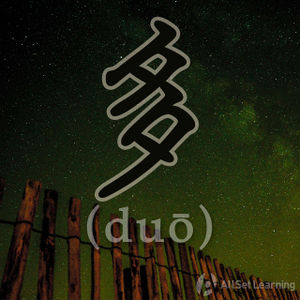Difference between revisions of "Asking about degree with "duo""
| Line 23: | Line 23: | ||
* 他 <em>多</em> 重?<span class="trans">How heavy is he?</span> | * 他 <em>多</em> 重?<span class="trans">How heavy is he?</span> | ||
* 外面 <em>多</em> 冷?<span class="trans">How cold is outside.</span> | * 外面 <em>多</em> 冷?<span class="trans">How cold is outside.</span> | ||
| − | * 你们 公司 <em>多</em> 大?<span class="trans"></span> | + | * 你们 公司 <em>多</em> 大?<span class="trans">How old is your company?</span> |
| − | * 她 <em>多</em> 漂亮?<span class="trans"></span> | + | * 她 <em>多</em> 漂亮?<span class="trans">How beautiful is she?</span> |
| − | * 川菜 <em>多</em> 好吃?<span class="trans"></span> | + | * 川菜 <em>多</em> 好吃?<span class="trans">How good is Sichuan food?</span> |
| − | * 外面 <em>多</em> 热?<span class="trans"></span> | + | * 外面 <em>多</em> 热?<span class="trans">How hot is it outside?</span> |
| − | * 这 个 人 <em>多</em> 好?<span class="trans"></span> | + | * 这 个 人 <em>多</em> 好?<span class="trans">How good is this person?</span> |
| − | * 你们 老板 <em>多</em> 大方?<span class="trans"></span> | + | * 你们 老板 <em>多</em> 大方?<span class="trans">How easy-mannered is Your boss?</span> |
* 她 爸 <em>多</em> 有钱?<span class="trans"></span> | * 她 爸 <em>多</em> 有钱?<span class="trans"></span> | ||
Revision as of 07:43, 1 November 2013
-
Level
-
Similar to
-
Used for
-
Keywords
In this article, we review how to ask about degree with 多(duō), which is one of the many uses of this character.
Structure
多 (duō) is often used to ask about the extent of something.
Subject + 多 + Adjective
This is an easy way to ask "How [adjective] is [subject]?"
Examples
- 她 多 高?How tall is she?
- 你 多 忙? How busy are you?
- 他 多 重?How heavy is he?
- 外面 多 冷?How cold is outside.
- 你们 公司 多 大?How old is your company?
- 她 多 漂亮?How beautiful is she?
- 川菜 多 好吃?How good is Sichuan food?
- 外面 多 热?How hot is it outside?
- 这 个 人 多 好?How good is this person?
- 你们 老板 多 大方?How easy-mannered is Your boss?
- 她 爸 多 有钱?
"大" and "小" are can also be used to describe ages. "你多大?" is often used to ask "how old are you?", however it is an informal way to ask, usually for close friends or children. Usually, "你几岁?" is used among peers.
See also
Sources and further reading
- Chinese: An Essential Grammar, Second Edition (pp. 135-7) →buy
- Integrated Chinese: Level 1, Part 1 (3rd ed) (pp. 233) →buy



